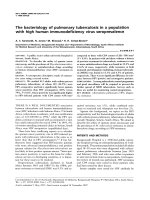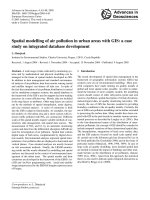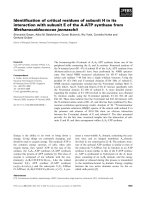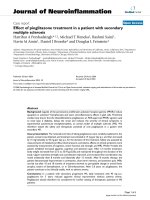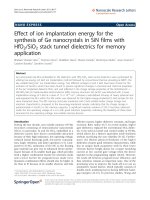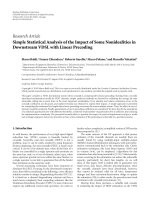Investigations of field dynamics in laser plasmas with proton imaging
Bạn đang xem bản rút gọn của tài liệu. Xem và tải ngay bản đầy đủ của tài liệu tại đây (3.14 MB, 138 trang )
Springer Theses
Recognizing Outstanding Ph.D. Research
For further volumes:
/>
Aims and Scope
The series ‘‘Springer Theses’’ brings together a selection of the very best Ph.D.
theses from around the world and across the physical sciences. Nominated and
endorsed by two recognized specialists, each published volume has been selected
for its scientific excellence and the high impact of its contents for the pertinent
field of research. For greater accessibility to non-specialists, the published versions
include an extended introduction, as well as a foreword by the student’s supervisor
explaining the special relevance of the work for the field. As a whole, the series
will provide a valuable resource both for newcomers to the research fields
described, and for other scientists seeking detailed background information on
special questions. Finally, it provides an accredited documentation of the valuable
contributions made by today’s younger generation of scientists.
Theses are accepted into the series by invited nomination only
and must fulfill all of the following criteria
• They must be written in good English.
• The topic of should fall within the confines of Chemistry, Physics and related
interdisciplinary fields such as Materials, Nanoscience, Chemical Engineering,
Complex Systems and Biophysics.
• The work reported in the thesis must represent a significant scientific advance.
• If the thesis includes previously published material, permission to reproduce this
must be gained from the respective copyright holder.
• They must have been examined and passed during the 12 months prior to
nomination.
• Each thesis should include a foreword by the supervisor outlining the significance of its content.
• The theses should have a clearly defined structure including an introduction
accessible to scientists not expert in that particular field.
Thomas Sokollik
Investigations of Field
Dynamics in Laser Plasmas
with Proton Imaging
Doctoral Thesis accepted by
Technical University, Berlin, Germany
123
Author
Dr. Thomas Sokollik
Lawrence Berkeley National Laboratory
Mail Stop 71R0259, 1 Cyclotron Road
Berkeley, CA 94720
USA
e-mail:
Supervisor
Prof. Wolfgang Sandner
Max-Born-Institute
Max-Born-Str. 2a
12489 Berlin
Germany
e-mail:
ISSN 2190-5053
e-ISSN 2190-5061
ISBN 978-3-642-15039-5
e-ISBN 978-3-642-15040-1
DOI 10.1007/978-3-642-15040-1
Springer Heidelberg Dordrecht London New York
Ó Springer-Verlag Berlin Heidelberg 2011
This work is subject to copyright. All rights are reserved, whether the whole or part of the material is
concerned, specifically the rights of translation, reprinting, reuse of illustrations, recitation, broadcasting, reproduction on microfilm or in any other way, and storage in data banks. Duplication of this
publication or parts thereof is permitted only under the provisions of the German Copyright Law of
September 9, 1965, in its current version, and permission for use must always be obtained from
Springer. Violations are liable to prosecution under the German Copyright Law.
The use of general descriptive names, registered names, trademarks, etc. in this publication does not
imply, even in the absence of a specific statement, that such names are exempt from the relevant
protective laws and regulations and therefore free for general use.
Cover design: eStudio Calamar, Berlin/Figueres
Printed on acid-free paper
Springer is part of Springer Science+Business Media (www.springer.com)
Supervisor’s Foreword
Laser plasma physics was established almost immediately after the invention of
the laser, now exactly fifty years ago. Pulsed laser light, even from early lasers, can
easily be focused to sufficiently high intensities for multi-photon or field ionization
to occur, turning matter into a plasma state. In addition, the momentum transfer
from the light pulse, directly proportional to the intensity, can be used to compress
the plasma, which can be further heated by a variety of light-matter interaction
phenomena. Hence, one may expect the plasma density and temperature to depend
crucially on the intensity of the focused laser light.
Laser technology has progressed tremendously over the last fifty years in
producing ever higher light intensities. One of the crucial parameters is the pulse
duration, which has advanced from nano- to pico- to femto-seconds. A tremendous
breakthrough was the implementation of the chirped pulse amplification technique
in the mid 1980s. It allowed the amplification of very energetic short pulses
without self-destruction of the laser and finally led to the creation of light fields of
so-called relativistic intensity. Electrons in such fields are accelerated close to the
velocity of light and their movement is governed by the laws of relativistic
kinematics. The properties of the laser—plasma interaction are influenced significantly by these effects. With modern lasers, reaching intensities well in excess
of 1020 W/cm2, the relativistic region is easily reached and extremely high plasma
energy densities can be achieved.
One of the consequences—potentially of considerable importance to society—
is the fact that the laser plasma is a brilliant source of photon and particle radiation.
While electro-magnetic radiation is expected under such conditions, laser plasmas
as a source of particle beams are less obvious and actually represent a relatively
young research field. It was discovered only about ten years ago that, in the
interaction of relativistic laser intensities with solid target foils, a considerable part
of the incident laser energy can be converted into kinetic energies of fast ions.
These arise either from contamination layers of the foil or from the target substrate
itself. This observation has triggered a wealth of theoretical and experimental
investigations. By now a variety of acceleration mechanisms has been identified,
v
vi
Supervisor’s Foreword
including direct acceleration of ultra-thin foils through momentum transfer from
the light pulse (radiation-pressure acceleration).
From an applications point of view (and compared to conventional accelerators)
laser acceleration of ions is still at its infancy. Parameters like monochromaticity,
beam stability and average power still need considerable improvement in order to
become competitive. One fascinating property of laser-accelerated ions, however,
is the fact that ion trajectories in the emitted beam show a laminar behavior with
nearly no crossing. The measure of this quality—the emittance—is two orders of
magnitude better than in conventional ion accelerators.
Such emittance allows for excellent resolution in imaging applications like
proton radiography. This is where the thesis of Thomas Sokollik takes up the
challenge. Specifically, he has developed a novel imaging technique and is the first
to apply it to measuring both the spatial and temporal evolution of ultrastrong
electrical fields in laser-driven plasmas. Proton radiography or simply proton
imaging of laser produced plasmas is performed here with two intense laser pulses.
One pulse creates the plasma which is to be probed, and the other produces a
proton beam acting as the probe. Hence, the laser-created protons helped in
imaging and understanding their own creation process.
Under the laser parameters of this work the Target Normal Sheath Acceleration
(TNSA) has been identified as the dominating ion acceleration scheme. Thereby
electric fields up to the order of MV/lm, arising from charge separation in the
laser-created plasma, accelerate ions to kinetic energies in the MeV energy range,
depending on the irradiation conditions. The fields arise on a pico-second time
scale, posing considerable challenges to any real-time probing scheme.
The advantage of laser driven proton/ion beams for imaging purposes are their
short emission time (of picosecond duration) and the low transversal emittance. In
addition, these beams usually have a broad kinetic energy distribution which is
considered a disadvantage for many applications, but has been turned into an
advantage in the present set-up. The introduction of a drift length between proton
creation and plasma sample results in a temporal separation of protons from different velocity classes and, hence, in a temporal resolution of the probing process.
The temporal resolution is preserved if the kinetic energy of the probing protons is
recorded together with their deflection due to the sample fields. Most elegantly,
this can be done in a dispersive spectrometer, where the proton velocity (corresponding to the probing time) is expanded along one axis while the field-induced
proton deflection occurs on an orthogonal axis. This method has been developed in
Thomas Sokollikt’s PhD work and has been called ‘‘proton streak deflectometry’’.
The method allows the continuous recording of the temporal evolution of a strong
field within a thin, two-dimensional probe layer.
The dynamics of electric fields which drive the ion acceleration depend crucially on electron transport processes in different target systems. Using the proton
streak deflectometry it was possible to show that lateral electron transport is one of
the key processes which determines extended field distributions and geometries
that influence beams of charged particles emerging from extended foil targets.
Consequently, the field dynamics should change if one can impose constraints on
Supervisor’s Foreword
vii
the lateral electron transport at the target system. Therefore, investigations were
extended to spatially confined targets, particularly micro-spheres or -droplets
which were earlier successfully used to create quasi mono-energetic proton beams.
The confined geometry of plasmas and fields was found to have positive effects on
the kinetic energy and spatial distribution of accelerated ions. This was shown both
in experimental radiography images and in numerical simulations, one of which
was selected for the cover page of Physical Review Letters. Finally, the results of
the thesis have triggered a very sophisticated new interaction experiment with
single levitated microspheres in a field trap. These recent results have shed light on
a surface plasma effect which had not been considered for isolatedmicro-targets so
far.
Time resolved proton radiography, as first applied in the present thesis, is not only
among the very first scientific applications of laser-accelerated protons. More
generally, the interplay between comprehensive diagnostics and full experimental
control over laser plasmas is the key to future optimization of laser-driven particle
acceleration itself. In the present work the utilization of the intrinsic low particle
beam emittance has already led to new insights into the plasma field dynamics
which, in turn, influence the energy distribution of laser accelerated protons. If
progress continues along such lines one may expect the vision of a new era of
accelerator physics and novel applications to come true.
Berlin, December 2010
Wolfgang Sandner
Acknowledgments
I would like to thank all those people, who have contributed to this work. Without
their help, constructive discussions and friendship this theses would not have been
possible.
Special thanks are given to the following people:
• Prof. Dr. W. Sandner for the possibility to work in this excellent research group
and his commitment in the Ph.D. seminar.
• Dr. P.V. Nickles for his dedication to the whole department.
• Dr. M. Schnürer for his outstanding competence, his support and mentoring.
• Dr. G. Priebe for much more than keeping the glass laser running.
• Dr. Ter-Avetisian for fruitful discussions.
• Dr. H. Stiel and Dr. H. Legall for reviewing an early version of this manuscript.
• Prof. Dr. A.A. Andreev for answering all my questions concerning theoretical
issues.
• S. Steinke for friendly support and visionary discussions.
• P. Friedrich for extraordinary commitment and support.
and all other administrative and technical employers: S. Szlapka, B. Haase,
G. Kommol, J. Meißner, J. Gläsel and D. Rohloff.
This work was partly supported by DFG—Sonderforschungsbereich Transregio
TR18.
Berlin, December 2010
Thomas Sokollik
ix
Contents
1
Introduction . . . . . . . . . . . . . . . . . . . . . . . . . . . . . . . . . . . . . . . .
References . . . . . . . . . . . . . . . . . . . . . . . . . . . . . . . . . . . . . . . . .
Part I
1
3
Basics
2
Ultra Short and Intense Laser Pulses
2.1 Mathematical Description . . . . .
2.2 Single Electron Interaction. . . . .
2.3 Ponderomotive Force . . . . . . . .
References . . . . . . . . . . . . . . . . . . . .
.
.
.
.
.
.
.
.
.
.
.
.
.
.
.
.
.
.
.
.
.
.
.
.
.
.
.
.
.
.
.
.
.
.
.
.
.
.
.
.
.
.
.
.
.
.
.
.
.
.
.
.
.
.
.
.
.
.
.
.
.
.
.
.
.
.
.
.
.
.
.
.
.
.
.
.
.
.
.
.
.
.
.
.
.
.
.
.
.
.
.
.
.
.
.
.
.
.
.
.
.
.
.
.
.
7
7
10
12
14
3
Plasma Physics . . . . . . . . . . . . . . .
3.1 Light Propagation in Plasmas .
3.2 Debye Length . . . . . . . . . . .
3.3 Plasma Expansion. . . . . . . . .
References . . . . . . . . . . . . . . . . . .
.
.
.
.
.
.
.
.
.
.
.
.
.
.
.
.
.
.
.
.
.
.
.
.
.
.
.
.
.
.
.
.
.
.
.
.
.
.
.
.
.
.
.
.
.
.
.
.
.
.
.
.
.
.
.
.
.
.
.
.
.
.
.
.
.
.
.
.
.
.
.
.
.
.
.
.
.
.
.
.
.
.
.
.
.
.
.
.
.
.
.
.
.
.
.
.
.
.
.
.
.
.
.
.
.
17
17
20
21
23
4
Ion Acceleration . . . . . . . . . . . . . . . . . . . . . . . . . . . .
4.1 Absorption Mechanisms . . . . . . . . . . . . . . . . . .
4.1.1 Resonance Absorption. . . . . . . . . . . . . . .
4.1.2 Brunel Absorption (Vacuum Heating) . . . .
4.1.3 Ponderomotive Acceleration, Hole Boring
and j 9 B Heating . . . . . . . . . . . . . . . . .
4.2 Target Normal Sheath Acceleration . . . . . . . . . .
4.3 Alternative Acceleration Mechanisms . . . . . . . . .
References . . . . . . . . . . . . . . . . . . . . . . . . . . . . . . . .
.
.
.
.
.
.
.
.
.
.
.
.
.
.
.
.
.
.
.
.
.
.
.
.
.
.
.
.
.
.
.
.
.
.
.
.
25
25
25
27
.
.
.
.
.
.
.
.
.
.
.
.
.
.
.
.
.
.
.
.
.
.
.
.
.
.
.
.
.
.
.
.
.
.
.
.
28
29
32
34
Laser System . . . . . . . . . . . . . . . . . . . . . . . . . . . . . . . . . . . . . . .
5.1 Ti:Sa Laser System. . . . . . . . . . . . . . . . . . . . . . . . . . . . . . .
5.2 Nd:glass Laser System . . . . . . . . . . . . . . . . . . . . . . . . . . . .
37
37
40
5
.
.
.
.
.
.
.
.
.
.
xi
xii
Contents
5.3 Synchronization . . . . . . . . . . . . . . . . . . . . . . . . . . . . . . . . .
References . . . . . . . . . . . . . . . . . . . . . . . . . . . . . . . . . . . . . . . . .
Part II
41
44
Proton Beam Characterization
6
Proton and Ion Spectra . . . . . . . . . . . . . . .
6.1 Thomson Spectrometer . . . . . . . . . . . .
6.2 Quasi-Monoenergetic Deuteron Bursts .
6.3 Irregularities of the Thomson Parabolas.
References . . . . . . . . . . . . . . . . . . . . . . . . .
.
.
.
.
.
.
.
.
.
.
.
.
.
.
.
.
.
.
.
.
.
.
.
.
.
.
.
.
.
.
.
.
.
.
.
.
.
.
.
.
.
.
.
.
.
.
.
.
.
.
.
.
.
.
.
.
.
.
.
.
.
.
.
.
.
.
.
.
.
.
.
.
.
.
.
.
.
.
.
.
47
47
50
51
52
7
Beam Emittance . . . .
7.1 Virtual Source .
7.2 Measurement of
References . . . . . . . .
.
.
.
.
.
.
.
.
.
.
.
.
.
.
.
.
.
.
.
.
.
.
.
.
.
.
.
.
.
.
.
.
.
.
.
.
.
.
.
.
.
.
.
.
.
.
.
.
.
.
.
.
.
.
.
.
.
.
.
.
.
.
.
.
55
56
57
59
8
Virtual Source Dynamics . . . . . . . . . . . . . . . . . . . . . . . . .
8.1 Energy Dependent Measurement of Pinhole Projections
8.2 Shape of the Proton Beam . . . . . . . . . . . . . . . . . . . . .
8.3 Energy Dependence of the Virtual Source . . . . . . . . . .
References . . . . . . . . . . . . . . . . . . . . . . . . . . . . . . . . . . . .
.
.
.
.
.
.
.
.
.
.
.
.
.
.
.
.
.
.
.
.
.
.
.
.
.
61
61
64
67
67
Part III
...............
...............
the Beam Emittance
...............
.
.
.
.
.
.
.
.
Proton Imaging
.
.
.
.
.
.
.
.
.
.
.
.
.
.
.
.
.
.
.
.
.
.
.
.
.
.
.
.
.
.
.
.
.
.
.
.
.
.
.
.
.
.
.
.
.
.
.
.
.
.
.
.
.
.
.
.
.
.
.
.
.
.
.
.
.
.
.
.
.
.
.
.
.
.
.
.
.
.
.
.
.
.
.
.
.
.
.
.
.
.
.
.
.
.
.
.
.
.
.
.
.
.
.
.
.
.
.
.
.
.
.
.
.
.
.
71
71
73
74
75
10 Imaging Plasmas of Irradiated Foils
10.1 Experimental Setup. . . . . . . . .
10.2 2D-Proton Images. . . . . . . . . .
References . . . . . . . . . . . . . . . . . . .
.
.
.
.
.
.
.
.
.
.
.
.
.
.
.
.
.
.
.
.
.
.
.
.
.
.
.
.
.
.
.
.
.
.
.
.
.
.
.
.
.
.
.
.
.
.
.
.
.
.
.
.
.
.
.
.
.
.
.
.
.
.
.
.
.
.
.
.
.
.
.
.
.
.
.
.
.
.
.
.
.
.
.
.
.
.
.
.
77
77
78
81
............
............
............
Water Droplets .
............
............
.
.
.
.
.
.
.
.
.
.
.
.
.
.
.
.
.
.
.
.
.
.
.
.
.
.
.
.
.
.
.
.
.
.
.
.
.
.
.
.
.
.
.
.
.
.
.
.
.
.
.
.
.
.
.
.
.
.
.
.
.
.
.
.
.
.
.
.
.
.
.
.
.
.
.
.
.
.
83
84
85
87
91
93
9
Principle of Proton Imaging . . . . .
9.1 Principle Experimental Setup .
9.2 Gated Multi-Channel Plates . .
9.3 Time Resolution . . . . . . . . . .
References . . . . . . . . . . . . . . . . . .
11 Mass-Limited Targets . . . . . . . .
11.1 Experimental Setup. . . . . .
11.2 Water Droplet Generation .
11.3 Proton Images of Irradiated
11.4 3D-Particle Tracing. . . . . .
References . . . . . . . . . . . . . . . .
Contents
xiii
12 Streak Deflectometry . . . . . . . . . . . . .
12.1 The Proton Streak Camera . . . . . .
12.2 Streaking Transient Electric Fields
12.3 Fitting Calculations. . . . . . . . . . .
12.4 Particle Tracing . . . . . . . . . . . . .
References . . . . . . . . . . . . . . . . . . . . .
.
.
.
.
.
.
97
97
99
101
103
106
13 Summary and Outlook . . . . . . . . . . . . . . . . . . . . . . . . . . . . . . . .
107
Part IV
.
.
.
.
.
.
.
.
.
.
.
.
.
.
.
.
.
.
.
.
.
.
.
.
.
.
.
.
.
.
.
.
.
.
.
.
.
.
.
.
.
.
.
.
.
.
.
.
.
.
.
.
.
.
.
.
.
.
.
.
.
.
.
.
.
.
.
.
.
.
.
.
.
.
.
.
.
.
.
.
.
.
.
.
.
.
.
.
.
.
.
.
.
.
.
.
.
.
.
.
.
.
.
.
.
.
.
.
.
.
.
.
.
.
Appendix
14 Zernike Polynomials . . . . . . . . . . . . . . . . . . . . . . . . . . . . . . . . . .
Reference . . . . . . . . . . . . . . . . . . . . . . . . . . . . . . . . . . . . . . . . . .
111
112
15 Gated MCPs . . . . . . . . . . . . . . . . . . . . . . . . . . . . . . . . . . . . . . .
113
Curriculum Vitae . . . . . . . . . . . . . . . . . . . . . . . . . . . . . . . . . . . . . . .
117
Index . . . . . . . . . . . . . . . . . . . . . . . . . . . . . . . . . . . . . . . . . . . . . . . .
121
Chapter 1
Introduction
Since the invention of the laser in the year 1960, a continuous progress in the
development of lasers has been made. Especially with the ‘‘Chirped Pulse
Amplification’’ (CPA) technique invented in 1985, a rapid enhancement of the laser
intensity was achieved in the last two decades which is still going on. The pulse
duration has been decreased down to a few femtoseconds. By focusing these pulses
tightly to several micrometers in diameter huge intensities are reached. The
interaction of these intense and short laser pulses with matter causes multifarious
phenomena which are in the focus of recent investigations. In general, one could
say that the laser pulse ionizes the atoms, creating a mixture of free electrons and
positively charged ions—also known as plasma.
At intensities of C 1013 W/cm2 only a fraction of the material is being ionized
and electrons can easily recombine with the ions. This phenomenon leads to nonlinear effects providing many important applications e.g. High-Harmonic generation (HHG) in gases and the generation of attosecond pulses. At higher intensities
the interaction of laser pulses with solids creates hot-dense plasmas which can be
used to construct X-ray lasers. If the laser intensity is increased further, the border
of the relativistic regime will be reached at intensities above 1018 W/cm2. This
regime is characterized by relativistic velocities of electrons accelerated in the
laser field. In this case relativistic effects and the magnetic component of the laser
field cannot be neglected anymore. Electrons as well as protons can be accelerated
up to energies of 1 GeV and 58 MeV [1, 2], respectively with laser systems which
are available today (*1021 W/cm2). In case of ions and protons, electric fields at
the rear side of irradiated solid targets are responsible for the acceleration. They
reach field strengths of about 1012 V/m with a lifetime of a several picoseconds.
These field dynamics are essential for the acceleration process and need to be
studied to understand the acceleration mechanisms.
The most pronounced differences to proton beams produced by conventional
accelerators are the low emittance (high laminarity) and the short duration of the
proton bunches (of the order of a picosecond at the source). Different applications
T. Sokollik, Investigations of Field Dynamics in Laser Plasmas
with Proton Imaging, Springer Theses, DOI: 10.1007/978-3-642-15040-1_1,
Ó Springer-Verlag Berlin Heidelberg 2011
1
2
1 Introduction
established recently benefit from these beam attributes. High-energy-density
matter can be created, which is of interest for astrophysics [3, 4]. Furthermore,
these beams are predestined for temporally and spatially resolved pump-probe
experiments like e.g. Proton Imaging.
Laser induced particle beams have also a high potential for future applications.
They could be injected into common accelerators, benefitting from the unique
attributes of the beams [4, 5]. Further on, the advantages of laser induced proton
beams are discussed in the scope of cancer therapy [6, 7]. Since a proton beam of a
certain energy deposits its energy mainly in the Bragg peak, it can be used to
destroy tumors in regions which are difficult to access surgically (e.g. eye, cerebric). The appealing idea is to produce and shape ion beams by intense laser light
much closer to the final interaction point, since light can be easily reflected by
mirrors whereas the ion beam transport in conventional accelerators requires huge
magnetic systems. Another possible medical application is the creation of radioisotopes used in positron emission tomography (PET) [8].
In fact, proton and ion beam parameters which are accessible today are far away
from being used in the above mentioned applications. Therefore further investigations of the acceleration mechanisms are required to achieve higher proton
energies and tailored proton spectra. The progress in this area of research is
growing rapidly and in the future this acceleration scheme could lead to very
compact and cost-efficient accelerators which might be also accessible to a broader
community than conventional accelerators today.
One possibility to reach these goals is to vary the laser parameters. The most
promising parameters are the intensity and the contrast of the laser pulse. Thus,
ever more powerful lasers are being built and new techniques for pulse cleaning
are being developed [9–11]. If these new laser parameters will be available in the
near future they will open a door to further physical processes and to new
acceleration schemes.
Another important issue is the choice of the target—the ion source. Recently
different target types were investigated to shape the ion beams. By using curved
targets the emission angle of the ion beam can be influenced. Concave targets can
focus or collimate the whole ion beam [3, 12–14]. To achieve tailored spectra,
especially monoenergetic ion beams, different approaches exist. For instance, in
reference [15] micro-structured targets were used. In reference [16] quasimonoenergetic ions are accelerated by heating the target and thus manipulating the
target surface. At the Max-Born-Institute it was shown for the first time that waterdroplet targets can deliver nearly monoenergetic deuteron and proton beams
[17, 18].
In the presented thesis different acceleration scenarios are investigated by using
different target types, in order to get a further insight into complex relations
between laser-plasma interaction and the associated strong fields. This knowledge
about the acceleration processes could help to improve and develop novel acceleration schemes. Beside the interest in these basic physically issues the motivation
for this research is to achieve knowledge to answer questions like: How can we
built laser-ion accelerators to achieve certain ion energies with tailored spectra
1 Introduction
3
most efficiently. Answers can be given with experiments and novel measurement
tools which are topics of this work.
A powerful diagnostic tool for these investigations is the proton beam itself. It
can be used to investigate the acceleration process by probing fields inside a
second laser-induced plasma where proton and ion acceleration takes place. This
technique is called ‘‘Proton Imaging’’ or ‘‘Proton Radiography’’ and is used for
several investigations presented in this thesis. Laser interactions with thin foils
and mass-limited targets (water-droplets) at laser intensities between 1017 and
1018 W/cm2 will be discussed. Therefore common proton imaging schemes were
adapted and developed further. These novel techniques allow detailed investigations of huge transient electric fields (108–1012 V/m) responsible for the proton
(ion) acceleration and connected to the expansion into the vacuum. Additionally,
investigations of the beam characteristics deliver information about the acceleration scenario and are included in this thesis.
References
1. W.P. Leemans, B. Nagler, A.J. Gonsalves, C. Toth, K. Nakamura, C.G.R. Geddes, E. Esarey,
C.B. Schroeder, S.M. Hooker, GeV electron beams from a centimetre-scale accelerator. Nat.
Phys. 2, 696 (2006)
2. R.A. Snavely, M.H. Key, S.P. Hatchett, T.E. Cowan, M. Roth, T.W. Phillips, M.A. Stoyer,
E.A. Henry, T.C. Sangster, M.S. Singh, S.C. Wilks, A. MacKinnon, A. Offenberger,
D.M. Pennington, K. Yasuike, A.B. Langdon, B.F. Lasinski, J. Johnson, M.D. Perry,
E.M. Campbell, Intense high-energy proton beams from Petawatt-Laser irradiation of solids.
Phys. Rev. Lett. 85(14), 2945 (2000)
3. P.K. Patel, A.J. Mackinnon, M.H. Key, T.E. Cowan, M.E. Foord, M. Allen, D.F. Price,
H. Ruhl, P.T. Springer, R. Stephens, Isochoric heating of solid-density matter with an
ultrafast proton beam. Phys. Rev. Lett. 91(12), 125004 (2003)
4. J. Fuchs, P. Antici, E. d’Humieres, E. Lefebvre, M. Borghesi, E. Brambrink, C.A. Cecchetti,
M. Kaluza, V. Malka, M. Manclossi, S. Meyroneinc, P. Mora, J. Schreiber, T. Toncian,
H. Pepin, R. Audebert, Laser-driven proton scaling laws and new paths towards energy
increase. Nat. Phys. 2(1), 48–54 (2006)
5. T.E. Cowan, J. Fuchs, H. Ruhl, A. Kemp, P. Audebert, M. Roth, R. Stephens, I. Barton,
A. Blazevic, E. Brambrink, J. Cobble, J. Fernandez, J.C. Gauthier, M. Geissel, M. Hegelich,
J. Kaae, S. Karsch, G.P. Le Sage, S. Letzring, M. Manclossi, S. Meyroneinc, A. Newkirk,
H. Pepin, N. Renard-LeGalloudec, Ultralow emittance, multi-MeV proton beams from a laser
virtual-cathode plasma accelerator. Phys. Rev. Lett. 92(20), 204801 (2004)
6. S.V. Bulanov, T.Z. Esirkepov, V.S. Khoroshkov, A.V. Kunetsov, F. Pegoraro, Oncological
hadrontherapy with laser ion accelerators. Phys. Lett. A 299(2–3), 240–247 (2002)
7. J. Fan, W. Luo, E. Fourkal, T. Lin, J. Li, I. Veltchev, C.M. Ma, Shielding design for a laseraccelerated proton therapy system. Phys. Med. Biol. 52(13), 3913–3930 (2007)
8. K.W.D. Ledingham, P. McKenna, R.P. Singhal, Applications for nuclear phenomena
generated by ultra-intense lasers. Science 300(5622), 1107–1111 (2003)
9. A. Jullien, O. Albert, F. Burgy, G. Hamoniaux, L.P. Rousseau, J.P. Chambaret,
F. Auge-Rochereau, G. Cheriaux, J. Etchepare, N. Minkovski, S.M. Saltiel, 10-10 temporal
contrast for femtosecond ultraintense lasers by cross-polarized wave generation. Opt. Lett.
30(8), 920–922 (2005)
4
1 Introduction
10. C. Thaury, F. Quere, J.P. Geindre, A. Levy, T. Ceccotti, P. Monot, M. Bougeard, F. Reau,
P. d/’Oliveira, P. Audebert, R. Marjoribanks, P. Martin, Plasma mirrors for ultrahighintensity optics. Nat. Phys. 3(6), 424–429 (2007)
11. M.P. Kalashnikov, E. Risse, H. Schonnagel, A. Husakou, J. Herrmann, W. Sandner,
Characterization of a nonlinear filter for the frontend of a high contrast double-CPA Ti:
sapphire laser. Opt. Exp. 12(21), 5088–5097 (2004)
12. J. Badziak, Laser-driven generation of fast particles. Opto-Electron. Rev. 15(1), 1–12 (2007)
13. T. Okada, A.A. Andreev, Y. Mikado, K. Okubo, Energetic proton acceleration and bunch
generation by ultraintense laser pulses on the surface of thin plasma targets. Phys. Rev. E
74(2), 5 (2006)
14. S.C. Wilks, A.B. Langdon, T.E. Cowan, M. Roth, M. Singh, S. Hatchett, M.H. Key,
D. Pennington, A. MacKinnon, R.A. Snavely, Energetic proton generation in ultra-intense
laser-solid interactions. Phys. Plasmas 8(2), 542–549 (2001)
15. H. Schwoerer, S. Pfotenhauer, O. Jackel, K.U. Amthor, B. Liesfeld, W. Ziegler, R. Sauerbrey,
K.W.D. Ledingham, T. Esirkepov, Laserplasma acceleration of quasi-monoenergetic protons
from microstructured targets. Nature 439(7075), 445–448 (2006)
16. B.M. Hegelich, B.J. Albright, J. Cobble, K. Flippo, S. Letzring, M. Paffett, H. Ruhl,
J. Schreiber, R.K. Schulze, J.C. Fernandez, Laser acceleration of quasi-monoenergetic MeV
ion beams. Nature 439(7075), 441–444 (2006)
17. S. Ter-Avetisyan, M. Schnurer, P.V. Nickles, M. Kalashnikov, E. Risse, T. Sokollik,
W. Sandner, A. Andreev, V. Tikhonchuk, Quasimonoenergetic deuteron bursts produced by
ultraintense laser pulses. Phys. Rev. Lett. 96(14), 145006 (2006)
18. A.V. Brantov, V.T. Tikhonchuk, O. Klimo, D.V. Romanov, S. Ter-Avetisyan, M. Schnurer,
T. Sokollik, P.V. Nickles, Quasi-monoenergetic ion acceleration from a homogeneous
composite target by an intense laser pulse. Phys. Plasmas 13(12), 10 (2006)
Part I
Basics
Chapter 2
Ultra Short and Intense Laser Pulses
In the following chapter fundamental aspects of laser pulses and their interaction
with single electrons will be discussed. At first the mathematical description of
laser pulses is given. The relation between time and frequency domain will be
explained and the concept of generating ultra short pulses will be sketched shortly.
Then the interaction of the laser pulse with single electrons in the relativistic case
will be discussed and the ponderomotive force will be introduced.
2.1 Mathematical Description
The electric field of short laser pulses can be described either in the time or the
frequency domain. Both formalisms are related to each other by the Fourier
transformation:
1
EðtÞ ¼ pffiffiffiffiffiffi
2p
Z1
~
EðxÞ
eixt dx;
ð2:1Þ
À1
1
~
EðxÞ
¼ pffiffiffiffiffiffi
2p
Z1
EðtÞeÀixt dt:
ð2:2Þ
À1
~
Due to the fact that E(t) is real, the symmetry of EðxÞ
is given as follows:
~
EðxÞ
¼ E~à ðÀxÞ;
ð2:3Þ
where (*) indicates the complex conjugated function. The symmetry shows that
the whole information of the pulse is already given in the positive part of the
function. Thus, the reduced function E~þ ðxÞ is defined as:
T. Sokollik, Investigations of Field Dynamics in Laser Plasmas
with Proton Imaging, Springer Theses, DOI: 10.1007/978-3-642-15040-1_2,
Ó Springer-Verlag Berlin Heidelberg 2011
7
8
2 Ultra Short and Intense Laser Pulses
E~þ ðxÞ ¼
&
~
EðxÞ
if
0
if
x!0
x\0
ð2:4Þ
The inverse Fourier transformation of E~þ ðxÞ delivers a description of the electric
field which is a complex function now. Thus, both functions can be expressed by
their amplitude and phase:
Eþ ðtÞ ¼ Aampl ðtÞ ei/ðtÞ ;
ð2:5Þ
~
~ ampl ðxÞ eÀi/ðxÞ
:
E~þ ðxÞ ¼ A
ð2:6Þ
~
The phase functions /(t) and /ðxÞ
can be developed by Taylor series:
/ðtÞ ¼
1
X
aj
j¼0
~
/ðxÞ
¼
j!
1
X
~
aj
j¼0
j!
t j;
ð2:7Þ
x j:
ð2:8Þ
The coefficients of the zeroth order (a0 ; a~0 ) represent a constant phase, which shifts
the carrier wave within the fixed envelope (‘‘carrier-envelope phase’’). The first
order coefficients (a1 ; a~1 ) shift the pulse in time and in frequency domain, respectively. With the slowly varying envelope approximation (SVEA) [1] a residual
phase can be defined where xL represents the central laser (angular) frequency:
uðtÞ ¼ /ðtÞ À xL t:
ð2:9Þ
The time dependent instantaneous (angular) frequency can be defined by:
xðtÞ ¼
d/ðtÞ
duðtÞ
¼ xL þ
:
dt
dt
ð2:10Þ
If the instantaneous frequency is constant in time the pulse is called unchirped and
represents a bandwidth-limited pulse, the shortest pulse which can be created with
a given spectral width. Pulse duration sL and spectral bandwidth Dxp are connected by:
sL DxL ! cB ;
ð2:11Þ
due to the Fourier transformation (Eqs. 2.1 and 2.2). The constant cB depends on
the spectral shape of the pulse (e.g. gaussian: cB ¼ 4 ln 2).
Higher (j C 1) orders of the spectral phase are often not temporally constant.
That means that the instantaneous frequency is changing in time. If the frequency
increases/decreases the pulse is called up-/down-chirped.1 A pulse with dxðtÞ=dt ¼
d 2 uðtÞ=dt2 ¼ a2 ¼ const is called linearly chirped, the frequency is changing
1
Alternative notation: positive-/negative-chirped.
2.1 Mathematical Description
9
linearly in time. Pulses gain higher orders of the spectral phase, e.g. by dispersion,
when propagating through material. In the Chirped Pulse Amplification (CPA) [2]
scheme a linear chirp is generated by different propagation distances of the spectral
components. The stretched pulse is amplified without the risk of damaging the
optical components (especially the amplifier crystals). After amplification the chirp
is compensated by a compressor consisting of two gratings mostly. Alternative
schemes exist to compensate higher orders (C1), for example chirped mirrors [3],
prisms or a deformable mirror in the compressor to vary the propagation length of
the spectral components.
Aside from generating bandwidth-limited pulses by flattening the spectral phase
a defined manipulation of the spectral components by a ‘‘pulse shaper’’ (e.g. a
liquid-crystal display in the spectral split beam) leads to special temporally shaped
pulses which are of interest for several applications [4, 5].
Assuming a constant phase the pulse duration is limited by the spectral bandwidth. To shorten the pulse duration further the bandwidth has to be increased. For
this, different methods can be used e.g. self-phase modulation (SPM) in gas-filled
hollow fibers [6], or the generation of pulse filaments in gas-filled tubes [7]. The
use of these techniques is limited to several mJ pulse energy. Self-phase modulation affects the phase and broadens the bandwidth without influencing the
temporal amplitude. Thus, an additional pulse compression is necessary. Recent
experiments at the Max-Born-Institute showed that under some conditions the
pulse can be self-compressed by pulse filamentation [8, 9]. Details concerning
these experiments, including measurements with the MBI TW laser can be found
in reference [9].
Using Eqs. 2.5 and 2.9 the electric field can be split into the complex envelope
function Aampl ðtÞ eiuðtÞ and the fast oscillating term eixL t :
Eþ ðtÞ ¼ Aampl ðtÞ eiuðtÞ Á eixL t :
ð2:12Þ
The real valued temporal electric field can be now reconstructed from E+(t) as
follows:
EðtÞ ¼ 2ReðEþ ðtÞÞ
ð2:13Þ
EðtÞ ¼ 2Aampl ðtÞ cosðxL t þ uðtÞÞ:
ð2:14Þ
Averaging the electric field, the temporal intensity can be calculated:
1
IðtÞ ¼ e0 c
T
tþT=2
Z
E2 ðt0 Þ dt0 :
ð2:15Þ
tÀT=2
If the slowly varying envelope approximation is valid Eq. 2.15 can be reduced to:
IðtÞ ¼ 2e0 cA2ampl ðtÞ:
ð2:16Þ
10
2 Ultra Short and Intense Laser Pulses
This formula defines the temporal intensity for a linear polarized laser pulse. In the
experiments the peak intensity is usually used to characterize the laser pulses:
1
I0 ¼ e0 cE02
2
ð2:17Þ
and is typically given in [W/cm2].
2.2 Single Electron Interaction
The motion of an electron caused by an electromagnetic field E and B in vacuum is
described by the Lorentz equation [1]:
dp d ðcme vÞ
¼
¼ ÀeðE þ v  BÞ:
ð2:18Þ
dt
dt
pffiffiffiffiffiffiffiffiffiffiffiffiffiffiffiffiffiffiffi
In the non-relativistic regime (c ¼ 1= 1 À v2 =c2 % 1) the electron oscillates in a
linearly polarized laser field with an amplitude (y0) and a maximum velocity (v0)
of:
y0 %
e E0
;
me x2L
v0 %
e E0
;
me xL
ð2:19Þ
assuming a plane wave (E0 = 2 Aampl) with the (angular) frequency xL. The
maximum velocity is used to define the dimensionless normalized vector potential
a0:
a0 ¼
v0
e E0
¼
:
c
me xL c
ð2:20Þ
Using Eqs. 2.17 and 2.20 the laser intensity is given by:
I0 ¼
a20 e0 m2e c5
a20
2
Á
ð2pÞ
%
Á 1:37 Á 1018 W/cm2 Á lm2 :
k2 2e2
k2
ð2:21Þ
To calculate the electron trajectories for a0 C 1, the equation of motion (Eq. 2.18)
has to be discussed fully relativistically. This corresponds to an intensity of
[1018 W/cm2. Assuming a linearly polarized plane wave propagating in the
x-direction with the vector potential A:
A ¼ ð0; A0 sin ðk x À xL tÞ; 0Þ;
ð2:22Þ
the electric and magnetic field can be described as follows:
E¼À
oA
¼ E0 cos ðk x À xL tÞ ey ;
ot
E0 ¼ xL A0
ð2:23Þ
